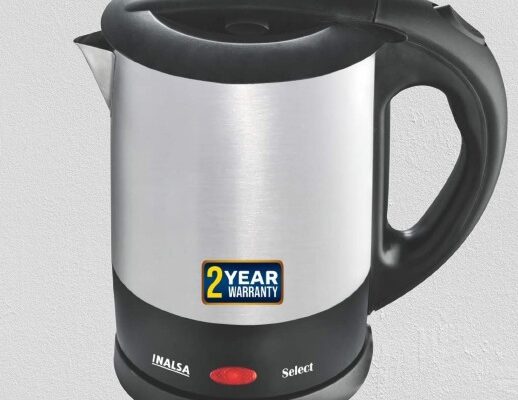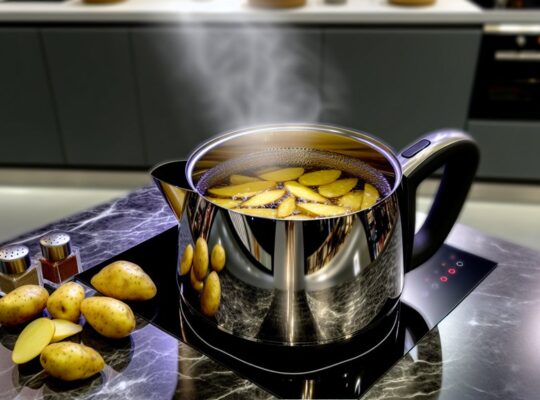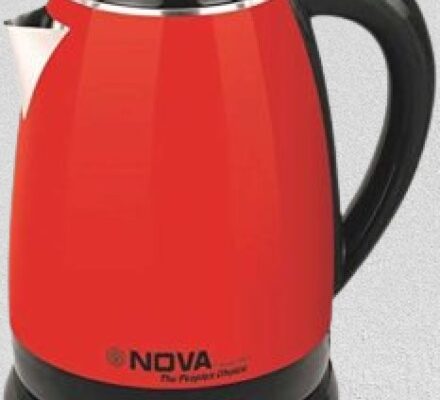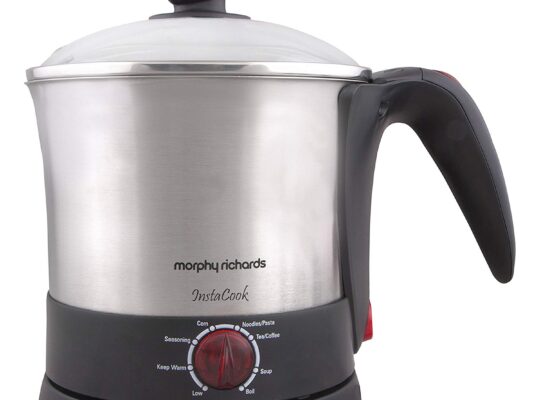Yes, you can boil milk in an electric kettle, but you should be cautious. Milk heats quickly and can scald, leading to spills and messes. It’s essential to monitor temperature since milk’s boiling point is slightly higher than water’s. Automatic shut-off features help, but not all kettles work well with dairy products. Be prepared for potential residue and cleaning challenges afterward. If you’re interested in further details on best practices and tips, there’s more to explore.
Key Takeaways
- Yes, you can boil milk in an electric kettle, but not all kettles are designed for dairy products.
- Electric kettles heat milk quickly and can have frothing capabilities for beverages.
- Monitor the milk closely to prevent foaming and spills during heating.
- Choose a kettle with an automatic shut-off feature to avoid overheating and damage.
- Clean the kettle immediately after use to prevent residue buildup and maintain longevity.
Understanding Electric Kettles
When you consider the convenience of modern kitchen appliances, electric kettles stand out for their efficiency and speed. There are various electric kettle types, including stainless steel, glass, and plastic, each with unique features. Stainless steel kettles offer durability and heat retention, while glass kettles allow you to monitor the water level. However, kettle safety is paramount when using any type. Always guarantee your kettle has an automatic shut-off feature to prevent overheating, and avoid overfilling it to reduce the risk of burns. Familiarizing yourself with the specific features and safety measures of your electric kettle can enhance your experience, guaranteeing that you enjoy the benefits of this versatile appliance without compromising on safety. Additionally, some electric kettles, like the KENT 16069 Super Egg Boiler, are designed for specific tasks, such as boiling eggs efficiently.
Benefits of Using Electric Kettles for Milk
Using an electric kettle to boil milk offers several advantages that enhance both efficiency and convenience in your kitchen. First, electric kettles heat milk quickly, saving you valuable time, especially when you’re in a rush. The precise temperature control helps prevent milk from scorching, ensuring a smooth texture. Additionally, many electric kettles come with a milk frothing feature, allowing you to create frothy beverages effortlessly. This is perfect for lattes or cappuccinos. Furthermore, the controlled heating minimizes the risk of cream separation, keeping your milk creamy and uniform. With an automatic shut-off feature, you won’t have to worry about overboiling. Overall, using an electric kettle simplifies the milk boiling process, making it a practical choice for your daily needs. Moreover, kettles like the V-Guard VKS17 Prime Electric Kettle provide features such as all-round heating for uniform milk heating, enhancing the boiling experience.
Risks of Boiling Milk in an Electric Kettle
While electric kettles are known for their convenience, boiling milk in them can pose several risks that users should be aware of.
- Milk overheating: Milk can easily scald and create a mess, potentially damaging the kettle.
- Foaming and spillage: As milk heats, it tends to foam, which can lead to dangerous spills.
- Kettle safety: Not all kettles are designed to handle dairy, risking malfunction or damage.
- Taste alteration: Continuous heating of milk can affect its flavor, leading to an unpleasant taste.
- Cleaning difficulties: Residue from boiled milk can be tough to clean, affecting the kettle’s longevity. Additionally, using an electric kettle for boiling milk can limit its versatile cooking needs, as it may not function optimally for other tasks afterward.
Key Differences Between Water and Milk Heating
When heating milk, you’ll encounter distinct differences compared to water, starting with their boiling points. Milk’s composition can lead to nutrient preservation challenges and potential scalding, which you won’t face with plain water. Additionally, the tendency of milk to foam requires careful attention to avoid spills during the heating process. Furthermore, using an electric kettle with precise temperature control can help prevent overheating and scalding of the milk.
Boiling Point Disparities
Although both water and milk may seem similar when heated, their boiling points reveal significant differences that affect how you should approach boiling them in an electric kettle. Water boils at 100°C (212°F), while milk’s boiling point is around 100-105°C (212-221°F) due to its fat and protein content. This slight increase in boiling temperature, combined with milk’s lower thermal conductivity, requires different boiling techniques to prevent scorching or overflowing.
- Milk tends to foam and froth more than water.
- The presence of proteins and fats alters heat distribution.
- Milk can scorch if heated too quickly.
- Different kettles may react differently with milk.
- Monitoring is essential when boiling milk to avoid messes.
Nutrient Preservation Challenges
Heating milk presents unique challenges in nutrient preservation compared to water, primarily due to its complex composition. Milk contains proteins, fats, and vitamins that are heat sensitive, making them prone to nutrient loss when exposed to high temperatures. Unlike water, which can boil without significant nutritional change, milk’s delicate balance can be disrupted, especially when heated rapidly in an electric kettle. For instance, essential nutrients like vitamin B12 and certain amino acids can degrade under excessive heat. This means that while boiling water might be straightforward, heating milk requires careful attention to temperature to minimize nutrient loss. Understanding these challenges can help you better preserve the nutritional integrity of milk during the heating process.
Foam and Scalding Issues
While boiling water may seem straightforward, heating milk introduces complexities like foam formation and scalding. Unlike water, milk contains proteins and fats that react differently to heat, which can lead to issues if you’re not careful.
- Foam formation can quickly create a mess, overflowing your kettle.
- Scalding occurs when milk reaches temperatures above 180°F (82°C), altering its taste and texture.
- Stirring milk while it heats helps distribute heat evenly, reducing the risk of scalding.
- Using a kettle with temperature control can aid in scalding prevention.
- Always monitor milk closely to avoid sudden boiling and foam spillover.
Tips for Safely Boiling Milk in an Electric Kettle
When boiling milk in an electric kettle, choosing the right kettle is essential to prevent scorching or overflowing. You’ll also need to monitor the temperature closely, as milk can quickly go from simmering to boiling over. By following these tips, you can safely achieve the perfect temperature for your milk. Additionally, using a kettle with temperature control features can help you maintain the ideal heat level while boiling milk.
Choose Appropriate Kettle
Choosing the right electric kettle is vital for safely boiling milk, as not all kettles are designed to handle this task effectively. When selecting a kettle, consider the following factors:
- Kettle Materials: Opt for stainless steel or glass, as they resist staining and retain heat better than plastic.
- Kettle Capacity: Choose a size that matches your needs; smaller kettles are easier to manage but may require multiple boils for larger quantities.
- Temperature Control: Look for models with adjustable temperature settings to prevent overheating.
- Automatic Shut-off: Confirm your kettle has this feature to avoid boiling dry and potential damage.
- Ease of Cleaning: Select a kettle with a wide opening for easy access and maintenance.
These factors will help you boil milk safely and efficiently.
Monitor Temperature Closely
To guarantee you successfully boil milk without scorching or overflowing, it’s crucial to monitor the temperature closely. Milk heats quickly, reaching its boiling point around 200°F (93°C), so you shouldn’t leave it unattended. Use a kitchen thermometer for accurate temperature monitoring, ensuring you can intervene before it boils over. As the milk heats, keep stirring to distribute the heat evenly and prevent sticking to the kettle’s bottom. Implementing safety precautions is important; if you notice the milk approaching its boiling point, reduce the heat or remove the kettle from the power source. By staying vigilant and adjusting as needed, you’ll maintain control and prevent mishaps, ensuring a smooth boiling process.
Cleaning and Maintenance After Boiling Milk
Although boiling milk in an electric kettle can be convenient, it often leaves behind stubborn residues that require prompt attention. To keep your kettle in top shape, employ effective cleaning techniques and adhere to maintenance tips.
- Rinse the kettle immediately after use to prevent milk from curdling.
- Use a mixture of vinegar and water to dissolve any stubborn deposits.
- Avoid abrasive cleaners that can scratch the kettle’s surface.
- Regularly check the heating element for buildup and clean it gently.
- Consider descaling your kettle periodically to maintain its efficiency.
Alternative Methods for Heating Milk
Cleaning your electric kettle after boiling milk can be a hassle, prompting many to explore alternative methods for heating milk. Several techniques can effectively warm milk while minimizing cleanup. Here’s a comparison of some popular methods:
| Method | Advantages |
|---|---|
| Stovetop | Precise temperature control |
| Microwave | Quick and convenient |
| Double Boiler | Gentle heating, prevents scorching |
| Milk Frother | Excellent for frothing, easy cleanup |
Each method has its merits depending on your needs. For instance, using a milk frother not only heats but also aerates milk, creating a creamy texture perfect for lattes. Consider these alternative heating options to find the one that best suits your routine.
User Experiences and Reviews
When you boil milk in an electric kettle, user experiences can vary considerably based on personal preferences and specific kettle models. Many users share their thoughts in milk boiling reviews, highlighting both positive outcomes and challenges.
- Some report quick and convenient heating, saving time in the kitchen.
- Others express concerns about the risk of milk spilling over the spout.
- Many appreciate the automatic shut-off feature, ensuring safety.
- A few highlight the importance of selecting a kettle with a non-stick interior to prevent burning.
- Some users recommend stirring the milk periodically for even heating.
Conclusion on Boiling Milk in Electric Kettles
Boiling milk in an electric kettle can be a practical solution for those looking to streamline their kitchen routine. However, it’s vital to take into account both milk texture and kettle safety. When you heat milk, it can froth and potentially spill over, which might damage the kettle or create a mess. To achieve the desired milk texture, keeping a close eye on the process is important. Make certain you’re using a kettle designed for dairy products, as some models may not handle the heat distribution well, leading to scorching. Always follow the manufacturer’s guidelines for safe use. Ultimately, while boiling milk in an electric kettle can be convenient, you must do so with caution to guarantee quality and safety.
Frequently Asked Questions
Can I Use Flavored Milk in an Electric Kettle?
You can use flavored milk in an electric kettle, but consider kettle safety. Flavored milk may leave residue or affect the kettle’s heating element, so make certain thorough cleaning afterward to maintain performance and hygiene.
How Long Does It Take to Boil Milk in an Electric Kettle?
Boiling milk in an electric kettle typically takes about 5 to 10 minutes, depending on the kettle settings. Monitoring the process is essential, as milk can easily scald or overflow if left unattended.
Is It Safe to Leave Milk Unattended While Boiling?
Leaving milk unattended while boiling poses significant risks due to its tendency to froth and spill over. Prioritize milk boiling safety by monitoring it closely, ensuring you prevent messy accidents and potential safety hazards.
What Type of Electric Kettle Is Best for Boiling Milk?
For boiling milk, choose a stainless steel kettle with a non-stick interior. This combination prevents scorching and guarantees even heating, making your process smoother and more efficient. Always check for temperature control features for ideal results.
Can I Boil Milk Directly From the Fridge in an Electric Kettle?
You can boil milk directly from the fridge in an electric kettle, but monitor the milk temperature closely. Also, verify proper kettle maintenance afterwards to prevent residue buildup and maintain peak performance for future use.
Conclusion
In summary, while boiling milk in an electric kettle can be convenient, it’s essential to understand the associated risks and differences between heating water and milk. If you choose to proceed, follow safety tips to avoid scalding and mess. Regular cleaning is vital to prevent residue buildup and maintain your kettle’s performance. Exploring alternative heating methods might also be worth considering for a more controlled process. Ultimately, weigh the pros and cons before deciding what’s best for you.



